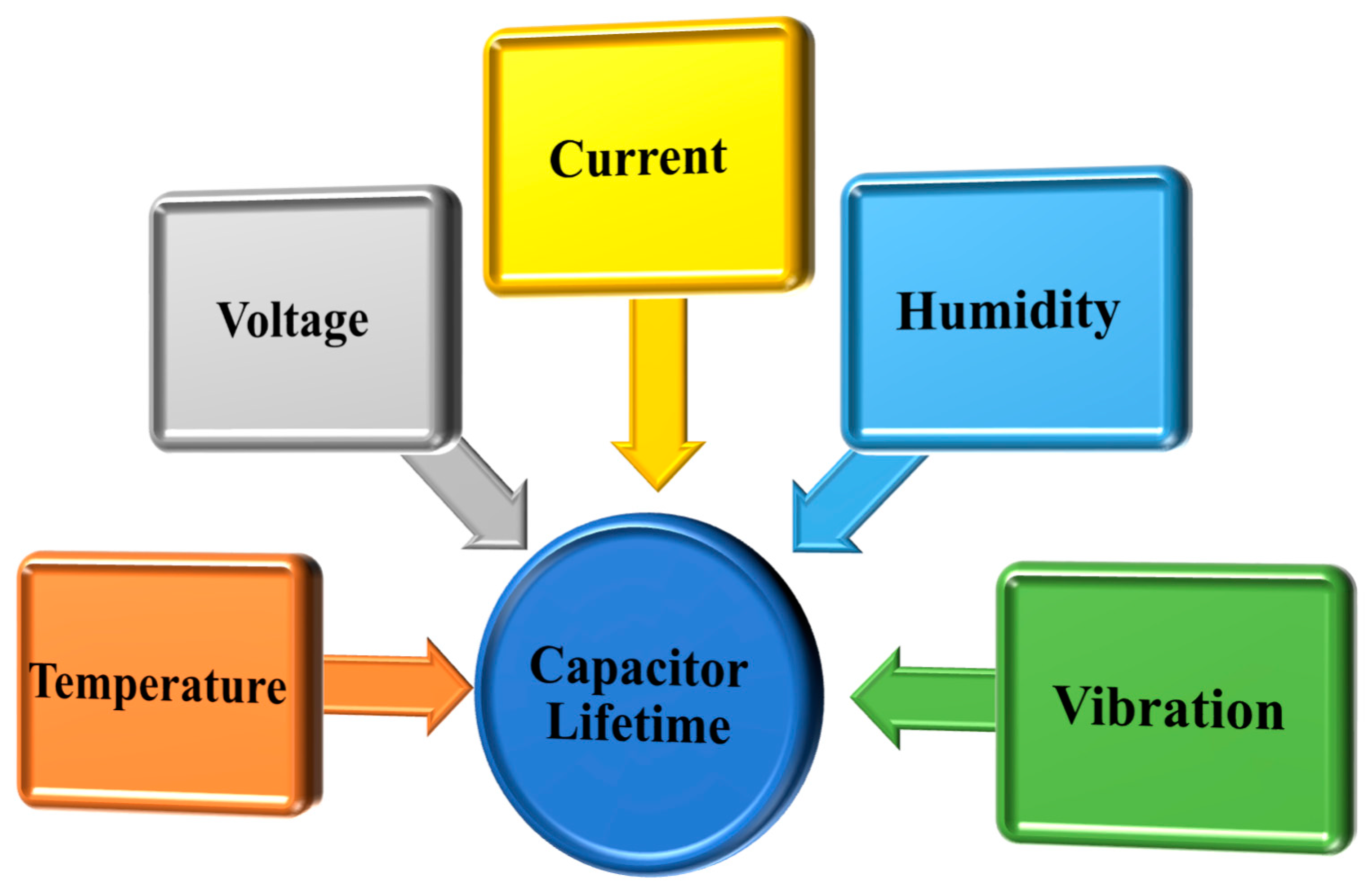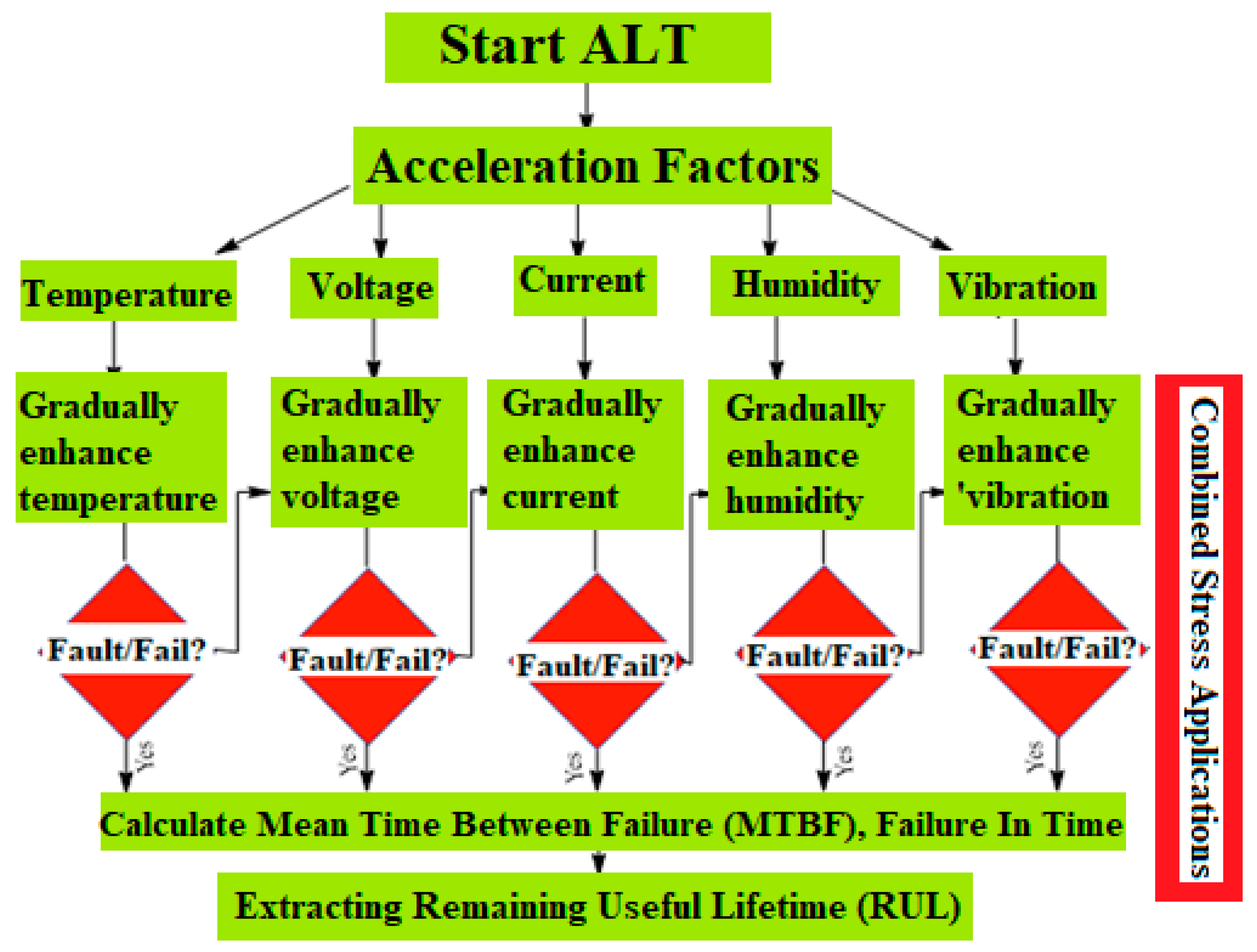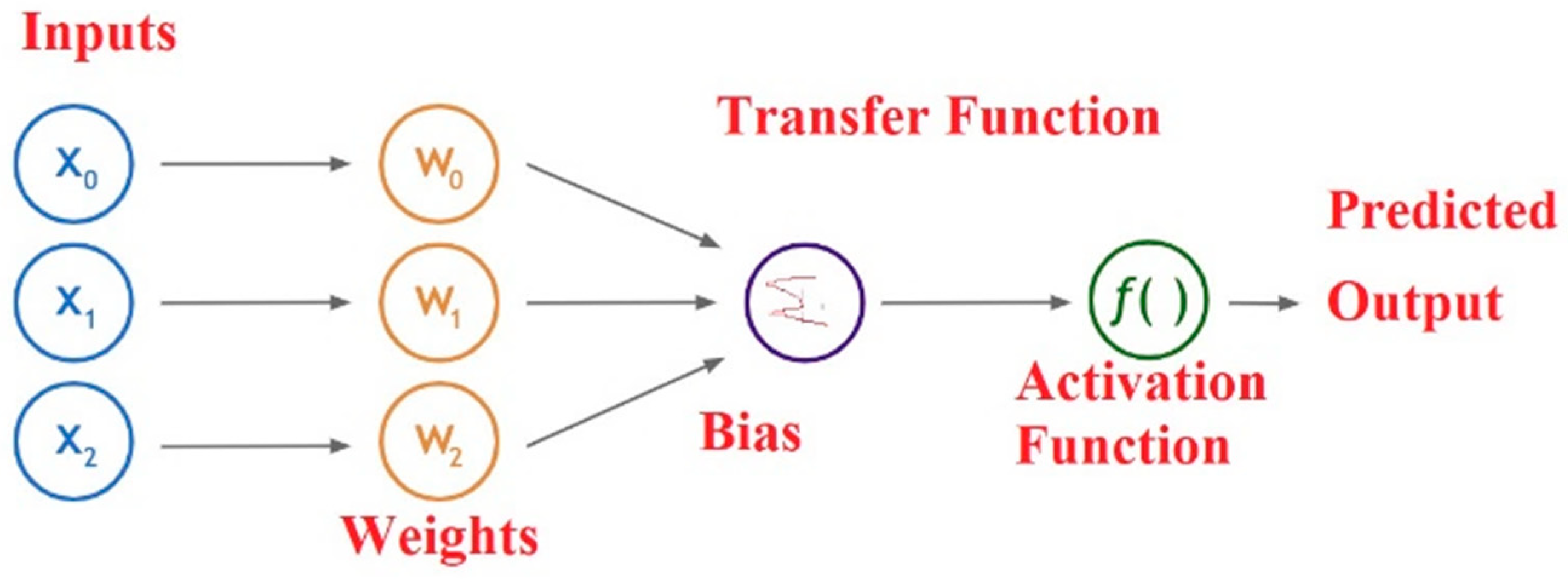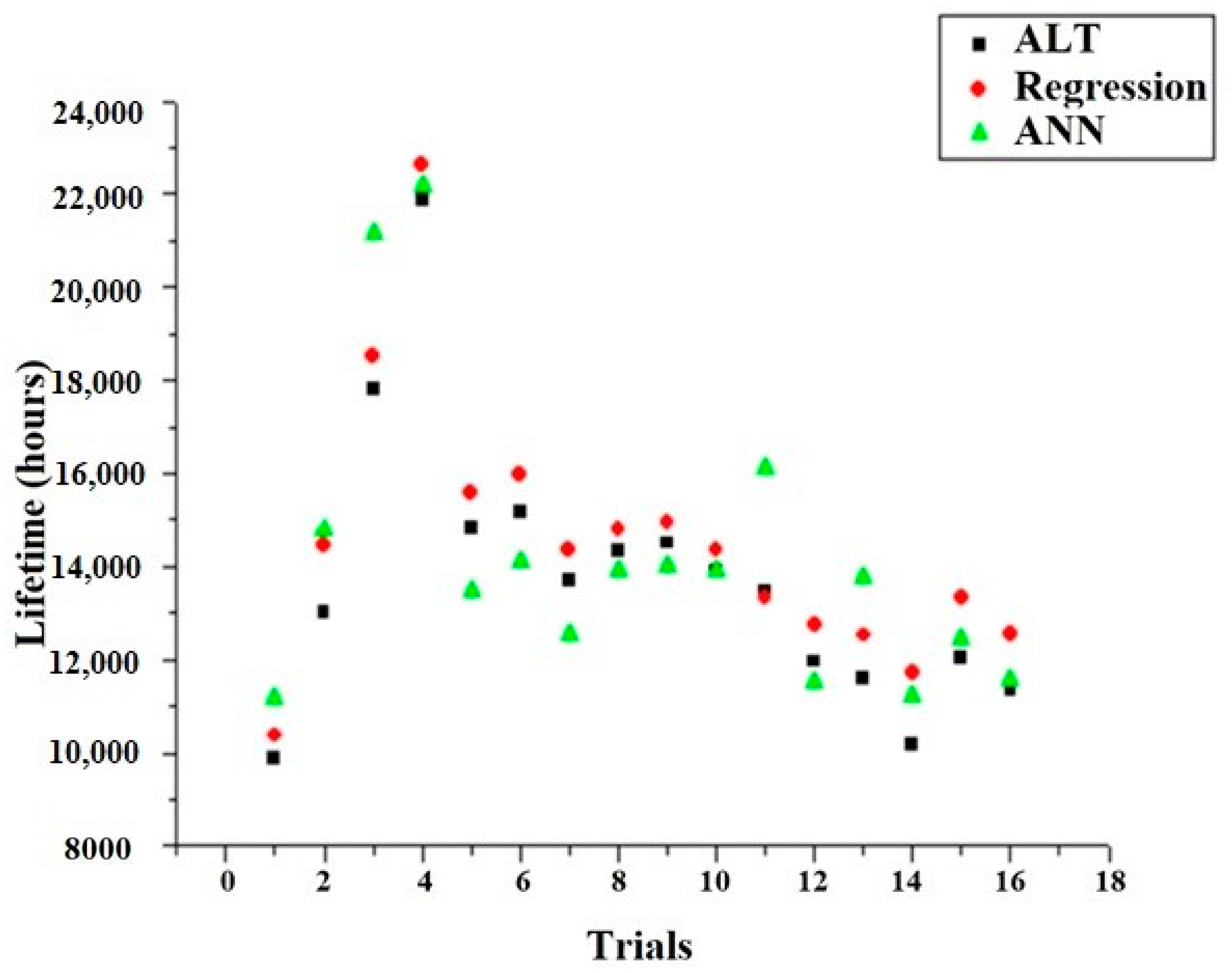Sustainability Analysis of a ZnO-NaCl-Based Capacitor Using Accelerated Life Testing and an Intelligent Modeling Approach
Abstract
:1. Introduction
2. Fabrication of the Capacitor
3. Remaining Useful Life Prediction of the Fabricated Capacitor
3.1. Remaining Useful Life Estimation Using Accelerated Life Testing (ALT)
3.2. Remaining Useful Life Estimation Using Statistical Analysis
3.3. Remaining Useful Life Estimation Using Artificial Neural Networks
4. Result and Discussion
4.1. Remaining Useful Life Assessment Using the Experimental Technique
4.2. Remaining Useful Life Assessment Using the Statistical Technique
4.3. Remaining Useful Life Prediction Using an Intelligent Technique
5. Comparative Analysis of Lifetime Calculated by Experimental, Statistical, and Intelligent Techniques
6. Results, Conclusions, and Scope of Further Research
Author Contributions
Funding
Institutional Review Board Statement
Informed Consent Statement
Data Availability Statement
Conflicts of Interest
References
- Wang, H.; Li, S.; Song, L.; Cui, L.; Wang, P. An enhanced intelligent diagnosis method based on multi-sensor image fusion via improved deep learning network. IEEE Trans. Instrum. Meas. 2019, 69, 2648–2657. [Google Scholar] [CrossRef]
- Kulkarni, R.; Soltani, M.; Wappler, P.; Guenther, T.; Fritz, K.-P.; Groezinger, T.; Zimmermann, A. Reliability Study of Electronic Components on Board-Level Packages Encapsulated by Thermoset Injection Molding. J. Manuf. Mater. Process. 2020, 4, 26. [Google Scholar] [CrossRef] [Green Version]
- Jiang, N.; Zhang, L.; Liu, Z.Q.; Sun, L.; Long, W.M.; He, P.; Xiong, M.Y.; Zhao, M. Reliability issues of lead-free solder joints in electronic devices. Sci. Technol. Adv. Mater. 2019, 20, 876–901. [Google Scholar] [CrossRef] [PubMed] [Green Version]
- Bhargava, C. Reliability Analysis: Need and Technique. In AI Techniques for Reliability Prediction for Electronic Components; Bhargava, C., Ed.; IGI Global: Hershey, PA, USA, 2019; Volume 1, pp. 1–44. [Google Scholar]
- Kalaiselvan, C.; Rao, L.B. Accelerated life testing of nano ceramic capacitors and capacitor test boards using non-parametric method. Measurement 2016, 88, 58–65. [Google Scholar] [CrossRef]
- Ahsan, M.; Hon, S.T.; Batunlu, C.; Albarbar, A. Reliability Assessment of IGBT Through Modelling and Experimental Testing. IEEE Access 2020, 8, 39561–39573. [Google Scholar] [CrossRef]
- Virk, S.M.; Muhammad, A.; Martinez-Enriquez, A. Fault prediction using artificial neural network and fuzzy logic. In Proceedings of the IEEE Seventh Mexican International Conference on Artificial Intelligence (MICAI’08), Atizapan de Zaragoza, Mexico, 27–31 October 2008; pp. 149–154. [Google Scholar]
- Özgür, Ü.; Alivov, Y.I.; Liu, C.; Teke, A.; Reshchikov, M.; Doğan, S.; Avrutin, V.; Cho, S.-J.; Morkoc, H. A comprehensive review of ZnO materials and devices. J. Appl. Phys. 2005, 98, 11. [Google Scholar] [CrossRef] [Green Version]
- Abrol, S.A.; Bhargava, C.; Sharma, P.K. Fabrication of DSSC using doctor blades method incorporating polymer electrolytes. Mater. Res. Express 2021, 8, 045010. [Google Scholar] [CrossRef]
- Kargar, A. Semiconductor Nanostructures for Solar Water Splitting and Hydrogen Production: Design, Growth/Fabrication, Characterization, and Device Performance; UC San Diego: La Jolla, CA, USA, 2015. [Google Scholar]
- Bhargava, C.; Sharma, P.K.; Senthilkumar, M.; Padmanaban, S.; Ramachandaramurthy, V.K.; Leonowicz, Z.; Blaabjerg, F.; Mitolo, M. Review of Health Prognostics and Condition Monitoring of Electronic Components. IEEE Access 2020, 8, 75163–75183. [Google Scholar] [CrossRef]
- Samavatian, V.; Imaneini, H.; Avenas, Y. Reliability Assessment of Multistate Degraded Systems: An Application to Power Electronic Systems. IEEE Trans. Power Electron. 2019, 35, 4024–4032. [Google Scholar] [CrossRef]
- Bhargava, C.; Banga, V.K.; Singh, Y. Failure prediction and health prognostics of electronic components: A review. In Proceedings of the IEEE Conference on Recent Advances in Engineering and Computational Sciences (RAECS), Chandigarh, India, 7–8 March 2014; pp. 1–5. [Google Scholar]
- Bhargava, C.; Banga, V.K. Failure Rate Prediction of Thyristor with Variable Duty Cycle and Change in Junction Temperature. In Proceedings of the 3rd International Conference of Electrical, Electronics, Instrumentation and Biomedical Engineering (ICEEIB’2015), Bangkok, Thailand, 26–27 December 2015; pp. 1–6. [Google Scholar]
- Bhargava, C.; Banga, V.K.; Singh, Y. Health Prognostics and Condition Monitoring of Electrolytic Ccapacitors. ACME Int. J. Multidiscip. Res. 2017, 5, 6–13. [Google Scholar]
- Antony, J.; Anand, R.B.; Kumar, M.; Tiwari, M. Multiple response optimization using Taguchi methodology and neuro-fuzzy based model. J. Manuf. Technol. Manag. 2006, 17, 908–925. [Google Scholar] [CrossRef]
- Naikan, V.; Rathore, A. Accelerated temperature and voltage life tests on aluminium electrolytic capacitors: A DOE approach. Int. J. Qual. Reliab. Manag. 2016, 33, 120–139. [Google Scholar] [CrossRef]
- Bhargava, C.; Banga, V.K.; Singh, Y. An intelligent prognostic model for electrolytic capacitors health monitoring: A design of experiments approach. Adv. Mech. Eng. 2018, 10, 1687814018781170. [Google Scholar] [CrossRef] [Green Version]
- Bhargava, C.; Banga, V.K.; Singh, Y. Condition Monitoring of aluminium electrolytic capacitors using accelerated life testing: A comparison. Int. J. Qual. Reliab. Manag. 2018, 35, 342–359. [Google Scholar] [CrossRef]
- Huang, X.; Denprasert, P.M.; Zhou, L.; Vest, A.N.; Kohan, S.; Loeb, G.E. Accelerated life-test methods and results for implantable electronic devices with adhesive encapsulation. Biomed. Microdevices 2017, 19, 46. [Google Scholar] [CrossRef]
- Shukla, R.; Ahmad, M.W.; Agarwal, N.; Anand, S. Accelerated Ageing of Aluminum Electrolytic Capacitor. In Proceedings of the National power electronic conference IIT, Banglore, India, 21–23 December 2015; pp. 1–5. [Google Scholar]
- Kurzweil, P.; Hildebrand, A.; Weiß, M. Accelerated Life Testing of Double-Layer Capacitors: Reliability and Safety under Excess Voltage and Temperature. ChemElectroChem 2015, 2, 150–159. [Google Scholar] [CrossRef]
- Bhargava, C.; Banga, V.K.; Singh, Y. Mathematical Modelling and Residual Life Prediction of an Aluminium Electrolytic Capacitor. J. Sci. Technol. 2018, 26, 785–798. [Google Scholar]
- Bhargava, C.; Banga, V.K.; Singh, Y. Health Prognostics of electrolytic capacitor using various environmental testing methods. J. Mater. Environ. Sci. 2018, 9, 503–511. [Google Scholar]
- Al-Zubaidi, S.; Ghani, J.A.; Haron, C.H.C. Prediction of tool life in end milling of Ti-6Al-4V alloy using artificial neural network and multiple regression models. Sains Malays. 2013, 42, 1735–1741. [Google Scholar]
- Bhargava, C.; Sharma, P.K. Artificial Intelligence: Fundamentals and Applications; CRC Press: Boca Raton, FL, USA, 2021. [Google Scholar]
- Bhargava, C.; Handa, M. An Intelligent Reliability Assessment technique for Bipolar Junction Transistor using Artificial Intelligence Techniques. Pertanika J. Sci. Technol. 2018, 26, 1765–1776. [Google Scholar]
- Bhargava, C. (Ed.) AI Techniques for Reliability Prediction for Electronic Components, 1st ed.; IGI Global: Hershey, PA, USA, 2019; Volume 1, p. 329. [Google Scholar]
- Bhargava, C.; Banga, V.K.; Singh, Y. Reliability Comparison of a Fabricated Humidity Sensor using Various Artificial Intelligence Techniques. Int. J. Perform. Eng. 2017, 13, 577. [Google Scholar] [CrossRef]
- Zhang, Z.; Friedrich, K. Artificial neural networks applied to polymer composites: A review. Compos. Sci. Technol. 2003, 63, 2029–2044. [Google Scholar] [CrossRef]
- Yan, S.; Zou, X.; Ilkhani, M.; Jones, A. An efficient multiscale surrogate modelling framework for composite materials considering progressive damage based on artificial neural networks. Compos. Part B Eng. 2020, 194, 108014. [Google Scholar] [CrossRef]
- Suresh, M.; Reddy, K.; Kolar, A.K. ANN-GA based optimization of a high ash coal-fired supercritical power plant. Appl. Energy 2011, 88, 4867–4873. [Google Scholar] [CrossRef]
- Yin, C.; Rosendahl, L.; Luo, Z. Methods to improve prediction performance of ANN models. Simul. Model. Pract. Theory 2003, 11, 211–222. [Google Scholar] [CrossRef]
- Berg, J.; Nyström, K. A unified deep artificial neural network approach to partial differential equations in complex geometries. Neurocomputing 2018, 317, 28–41. [Google Scholar] [CrossRef] [Green Version]
- Karlik, B.; Aydin, S. An improved approach to the solution of inverse kinematics problems for robot manipulators. Eng. Appl. Artif. Intell. 2000, 13, 159–164. [Google Scholar] [CrossRef]
- Pleune, T.T.; Chopra, O.K. Using artificial neural networks to predict the fatigue life of carbon and low-alloy steels. Nucl. Eng. Des. 2000, 197, 1–12. [Google Scholar] [CrossRef]
- Dande, P.; Samant, P. Acquaintance to artificial neural networks and use of artificial intelligence as a diagnostic tool for tuberculosis: A review. Tuberculosis 2018, 108, 1–9. [Google Scholar] [CrossRef]
- Sajja, P.S. Examples and Applications on Artificial Neural Networks. In Illustrated Computational Intelligence; Springer: Berlin/Heidelberg, Germany, 2021; pp. 101–153. [Google Scholar]
- Khan, M.T.; Kaushik, A.C.; Ji, L.; Malik, S.I.; Ali, S.; Wei, D.Q. Artificial Neural Networks for Prediction of Tuberculosis Disease. Front. Microbiol. 2019, 10, 395. [Google Scholar] [CrossRef]
- Bharati, S.; Podder, P.; Mondal, M. Artificial neural network based breast cancer screening: A comprehensive review. arXiv 2020, arXiv:2006.01767. [Google Scholar]
- Pérez-Pérez, E.; López-Estrada, F.; Valencia-Palomo, G.; Torres, L.; Puig, V.; Mina-Antonio, J. Leak diagnosis in pipelines using a combined artificial neural network approach. Control Eng. Pract. 2021, 107, 104677. [Google Scholar] [CrossRef]
- Rajeev, D.; Dinakaran, D.; Singh, S. Artificial neural network based tool wear estimation on dry hard turning processes of AISI4140 steel using coated carbide tool. Bull. Pol. Acad. Sci. Tech. Sci. 2017, 65, 553–559. [Google Scholar] [CrossRef]
- Patel, J.; Shah, S.; Thakkar, P.; Kotecha, K. Predicting stock and stock price index movement using trend deterministic data preparation and machine learning techniques. Expert Syst. Appl. 2015, 42, 259–268. [Google Scholar] [CrossRef]
- Patel, J.; Shah, S.; Thakkar, P.; Kotecha, K. Predicting stock market index using fusion of machine learning techniques. Expert Syst. Appl. 2015, 42, 2162–2172. [Google Scholar] [CrossRef]
- Mazhar, M.; Kara, S.; Kaebernick, H. Remaining life estimation of used components in consumer products: Life cycle data analysis by Weibull and artificial neural networks. J. Oper. Manag. 2007, 25, 1184–1193. [Google Scholar] [CrossRef]
- Liu, E.; Zhang, D. Diagnosis of component failures in the space shuttlemain engines using Bayesian belief network: A feasibility study. Int. J. Artif. Intell. Tools 2003, 12, 355–374. [Google Scholar] [CrossRef]
- Tian, Z. An artificial neural network method for remaining useful life prediction of equipment subject to condition monitoring. J. Intell. Manuf. 2012, 23, 227–237. [Google Scholar] [CrossRef]
- Choudrie, J.; Banerjee, S.; Kotecha, K.; Walambe, R.; Karende, H.; Ameta, J. Machine learning techniques and older adults processing of online information and misinformation: A covid 19 study. Comput. Hum. Behav. 2021, 119, 106716. [Google Scholar] [CrossRef]
- Simulink, M.; Natick, M. The Mathworks; Carlsbad, CA, USA, 1993; pp. 22–197. [Google Scholar]
- Lefik, M. Some aspects of application of artificial neural network for numerical modeling in civil engineering. Bull. Pol. Acad. Sci. Tech. Sci. 2013, 61, 39–50. [Google Scholar] [CrossRef]
- Abrol, S.A.; Bhargava, C.; Sharma, P.K. Reliability analysis and condition monitoring of polymer based dye sensitized solar cell: A DOE approach. Mater. Res. Express 2021, 8, 045309. [Google Scholar] [CrossRef]
- Whitman, C.S. Impact of ambient temperature set point deviation on Arrhenius estimates. Microelectron. Reliab. 2012, 52, 2–8. [Google Scholar] [CrossRef]
- Gokulachandran, J.; Mohandas, K. Prediction of cutting tool life based on Taguchi approach with fuzzy logic and support vector regression techniques. Int. J. Qual. Reliab. Manag. 2015, 32, 270–290. [Google Scholar] [CrossRef]
- Si, X.-S.; Wang, W.; Hu, C.-H.; Zhou, D.-H. Remaining useful life estimation—A review on the statistical data driven approaches. Eur. J. Oper. Res. 2011, 213, 1–14. [Google Scholar] [CrossRef]
- Rausand, M.; Arnljot, H. System Reliability Theory: Models, Statistical Methods, and Applications; John Wiley & Sons: Hoboken, NJ, USA, 2004; Volume 396. [Google Scholar]
- Reynolds, G.J.; Kratzer, M.; Dubs, M.; Felzer, H.; Mamazza, R. Sputtered Modified Barium Titanate for Thin-Film Capacitor Applications. Materials 2012, 5, 575–589. [Google Scholar] [CrossRef] [PubMed]








| Parameters | Units | Notation | Level | |||
|---|---|---|---|---|---|---|
| Low (1) | Medium (2) | High (3) | Extreme (4) | |||
| Temperature | °C | t | 75 | 85 | 95 | 105 |
| Voltage | V | v | 4.2 | 4.8 | 5.4 | 6.0 |
| Current | Ma | i | 24 | 26 | 28 | 30 |
| Humidity | Rh | r | 77 | 80 | 83 | 86 |
| Vibration | Hz | vb | 23 | 26 | 29 | 32 |
| Trials | Process Parameters (Factors) | ||||
|---|---|---|---|---|---|
| Temperature (°C) | Voltage (V) | Current (mA) | Humidity (Rh) | Vibration (Hz) | |
| 1 | 1 | 1 | 1 | 1 | 1 |
| 2 | 1 | 2 | 2 | 2 | 2 |
| 3 | 1 | 3 | 3 | 3 | 3 |
| 4 | 1 | 4 | 4 | 4 | 4 |
| 5 | 2 | 1 | 2 | 3 | 4 |
| 6 | 2 | 2 | 1 | 4 | 3 |
| 7 | 2 | 3 | 4 | 1 | 2 |
| 8 | 2 | 4 | 3 | 2 | 1 |
| 9 | 3 | 1 | 3 | 4 | 2 |
| 10 | 3 | 2 | 4 | 3 | 1 |
| 11 | 3 | 3 | 1 | 2 | 4 |
| 12 | 3 | 4 | 2 | 1 | 3 |
| 13 | 4 | 1 | 4 | 2 | 3 |
| 14 | 4 | 2 | 3 | 1 | 4 |
| 15 | 4 | 3 | 2 | 4 | 1 |
| 16 | 4 | 4 | 1 | 3 | 2 |
| Application Industry | References | Area of Application |
|---|---|---|
| Composite science | [30,31] | Selection of suitable composite as per application. |
| Coal industry | [32,33] | Relate ultimate and proximate analysis data. |
| Problem-solving in industrial applications | [34,35,36] | Solve complex and time-consuming problems. |
| Medical field | [37,38,39,40] | Diagnostic tool for tuberculosis, tumors, diabetes, etc. |
| Mechanical | [41,42] | Leak diagnosis in pipes, recognition of medical tools, etc. |
| Trials | Process Parameters (Factors) | Output | ||||
|---|---|---|---|---|---|---|
| Temperature (°C) | Voltage (V) | Current (mA) | Humidity (Rh) | Vibration (Hz) | ALT Remaining Useful Life (Hours) | |
| 1 | 75 | 4.2 | 24 | 77 | 23 | 9875.4 |
| 2 | 75 | 4.8 | 26 | 80 | 26 | 13,012.4 |
| 3 | 75 | 5.4 | 28 | 83 | 29 | 17,811.8 |
| 4 | 75 | 6 | 30 | 86 | 32 | 21,887.6 |
| 5 | 85 | 4.2 | 26 | 83 | 32 | 14,818.1 |
| 6 | 85 | 4.8 | 24 | 86 | 29 | 15,161.5 |
| 7 | 85 | 5.4 | 30 | 77 | 26 | 13,714.5 |
| 8 | 85 | 6 | 28 | 80 | 23 | 14,317.9 |
| 9 | 95 | 4.2 | 28 | 86 | 26 | 14,513.2 |
| 10 | 95 | 4.8 | 30 | 83 | 23 | 13,887.3 |
| 11 | 95 | 5.4 | 24 | 80 | 32 | 13,450.5 |
| 12 | 95 | 6 | 26 | 77 | 29 | 11,966.3 |
| 13 | 105 | 4.2 | 30 | 80 | 29 | 11,600.4 |
| 14 | 105 | 4.8 | 28 | 77 | 32 | 10,190.3 |
| 15 | 105 | 5.4 | 26 | 86 | 23 | 12,047.9 |
| 16 | 105 | 6 | 24 | 83 | 26 | 11,335.2 |
| Methods | Performance Parameters | ||
|---|---|---|---|
| Root Mean Square Error (RMSE) | Mean Absolute Error (MAE) | Correlation Coefficient (CC) | |
| Regression Remaining Useful Life (Years) | 0.102 | 0.092 | 0.989 |
| ANN Remaining Useful Life (Years) | 0.167 | 0.13 | 0.898 |
| Trials | Process Parameters (Factors) | Output | ||||
|---|---|---|---|---|---|---|
| Temperature (°C) | Voltage (V) | Current (mA) | Humidity (Rh) | Vibration (Hz) | Regression Remaining Useful Life (Hours) | |
| 1 | 75 | 4.2 | 24 | 77 | 23 | 10,375.2 |
| 2 | 75 | 4.8 | 26 | 80 | 26 | 14,458.7 |
| 3 | 75 | 5.4 | 28 | 83 | 29 | 18,542.2 |
| 4 | 75 | 6 | 30 | 86 | 32 | 22,625.7 |
| 5 | 85 | 4.2 | 26 | 83 | 32 | 15,571.7 |
| 6 | 85 | 4.8 | 24 | 86 | 29 | 15,984.6 |
| 7 | 85 | 5.4 | 30 | 77 | 26 | 14,370.3 |
| 8 | 85 | 6 | 28 | 80 | 23 | 14,783.2 |
| 9 | 95 | 4.2 | 28 | 86 | 26 | 14,964.1 |
| 10 | 95 | 4.8 | 30 | 83 | 23 | 14,363.4 |
| 11 | 95 | 5.4 | 24 | 80 | 32 | 13,345.5 |
| 12 | 95 | 6 | 26 | 77 | 29 | 12,744.8 |
| 13 | 105 | 4.2 | 30 | 80 | 29 | 12,523.2 |
| 14 | 105 | 4.8 | 28 | 77 | 32 | 11,713.9 |
| 15 | 105 | 5.4 | 26 | 86 | 23 | 13,349 |
| 16 | 105 | 6 | 24 | 83 | 26 | 125,39.7 |
| Trials | Process Parameters (Factors) | Output | ||||
|---|---|---|---|---|---|---|
| Temperature (°C) | Voltage (V) | Current (mA) | Humidity (Rh) | Vibration (Hz) | ANN Remaining Useful Life (Hours) | |
| 1 | 75 | 4.2 | 24 | 77 | 23 | 11,188.1 |
| 2 | 75 | 4.8 | 26 | 80 | 26 | 14,799.1 |
| 3 | 75 | 5.4 | 28 | 83 | 29 | 21,150.2 |
| 4 | 75 | 6 | 30 | 86 | 32 | 22,181.1 |
| 5 | 85 | 4.2 | 26 | 83 | 32 | 13,454.5 |
| 6 | 85 | 4.8 | 24 | 86 | 29 | 14,130.7 |
| 7 | 85 | 5.4 | 30 | 77 | 26 | 12,557.8 |
| 8 | 85 | 6 | 28 | 80 | 23 | 13,932.8 |
| 9 | 95 | 4.2 | 28 | 86 | 26 | 14,007.6 |
| 10 | 95 | 4.8 | 30 | 83 | 23 | 13,919.9 |
| 11 | 95 | 5.4 | 24 | 80 | 32 | 16,121.8 |
| 12 | 95 | 6 | 26 | 77 | 29 | 11,507.9 |
| 13 | 105 | 4.2 | 30 | 80 | 29 | 13,787.5 |
| 14 | 105 | 4.8 | 28 | 77 | 32 | 11,216.7 |
| 15 | 105 | 5.4 | 26 | 86 | 23 | 12,432.9 |
| 16 | 105 | 6 | 24 | 83 | 26 | 11,565.2 |
| Trials | Output | Error Analysis | |||
|---|---|---|---|---|---|
| ALT Remaining Useful Life (Hours) | Regression Remaining Useful Life (Hours) | ANN Remaining Useful Life (Hours) | Error between ALT and Statistical | Error between ALT and ANN | |
| 1 | 9875.4 | 10,375.2 | 11,188.1 | −5.06106 | −13.293 |
| 2 | 13,012.4 | 14,458.7 | 14,799.1 | −11.1148 | −13.731 |
| 3 | 17,811.8 | 18,542.2 | 21,150.2 | −4.10065 | −18.743 |
| 4 | 21,887.6 | 22,625.7 | 22,181.1 | −3.37223 | −1.3409 |
| 5 | 14,818.1 | 15,571.7 | 13,454.5 | −5.08567 | 9.20226 |
| 6 | 15,161.5 | 15,984.6 | 14,130.7 | −5.42888 | 6.7988 |
| 7 | 13,714.5 | 14,370.3 | 12,557.8 | −4.7818 | 8.43414 |
| 8 | 14,317.9 | 14,783.2 | 13,932.8 | −3.24978 | 2.68964 |
| 9 | 14,513.2 | 14,964.1 | 14,007.6 | −3.10683 | 3.48373 |
| 10 | 13,887.3 | 14,363.4 | 13,919.9 | −3.42831 | −0.2347 |
| 11 | 13,450.5 | 13,345.5 | 16,121.8 | 0.78064 | −19.86 |
| 12 | 11,966.3 | 12,744.8 | 11,507.9 | −6.50577 | 3.83076 |
| 13 | 11,600.4 | 12,523.2 | 13,787.5 | −7.9549 | −18.854 |
| 14 | 10,190.3 | 11,713.9 | 11,216.7 | −14.9515 | −10.072 |
| 15 | 12,047.9 | 13,349 | 12,432.9 | −10.7994 | −3.1956 |
| 16 | 11,335.2 | 12,539.7 | 11,565.2 | −10.6262 | −2.0291 |
| Average Error (%) | 6.17 | 4.18 | |||
| Average Accuracy (%) | 93.83 | 95.82 | |||
Publisher’s Note: MDPI stays neutral with regard to jurisdictional claims in published maps and institutional affiliations. |
© 2021 by the authors. Licensee MDPI, Basel, Switzerland. This article is an open access article distributed under the terms and conditions of the Creative Commons Attribution (CC BY) license (https://creativecommons.org/licenses/by/4.0/).
Share and Cite
Sharma, P.K.; Bhargava, C.; Kotecha, K. Sustainability Analysis of a ZnO-NaCl-Based Capacitor Using Accelerated Life Testing and an Intelligent Modeling Approach. Sustainability 2021, 13, 10736. https://doi.org/10.3390/su131910736
Sharma PK, Bhargava C, Kotecha K. Sustainability Analysis of a ZnO-NaCl-Based Capacitor Using Accelerated Life Testing and an Intelligent Modeling Approach. Sustainability. 2021; 13(19):10736. https://doi.org/10.3390/su131910736
Chicago/Turabian StyleSharma, Pardeep Kumar, Cherry Bhargava, and Ketan Kotecha. 2021. "Sustainability Analysis of a ZnO-NaCl-Based Capacitor Using Accelerated Life Testing and an Intelligent Modeling Approach" Sustainability 13, no. 19: 10736. https://doi.org/10.3390/su131910736
APA StyleSharma, P. K., Bhargava, C., & Kotecha, K. (2021). Sustainability Analysis of a ZnO-NaCl-Based Capacitor Using Accelerated Life Testing and an Intelligent Modeling Approach. Sustainability, 13(19), 10736. https://doi.org/10.3390/su131910736








